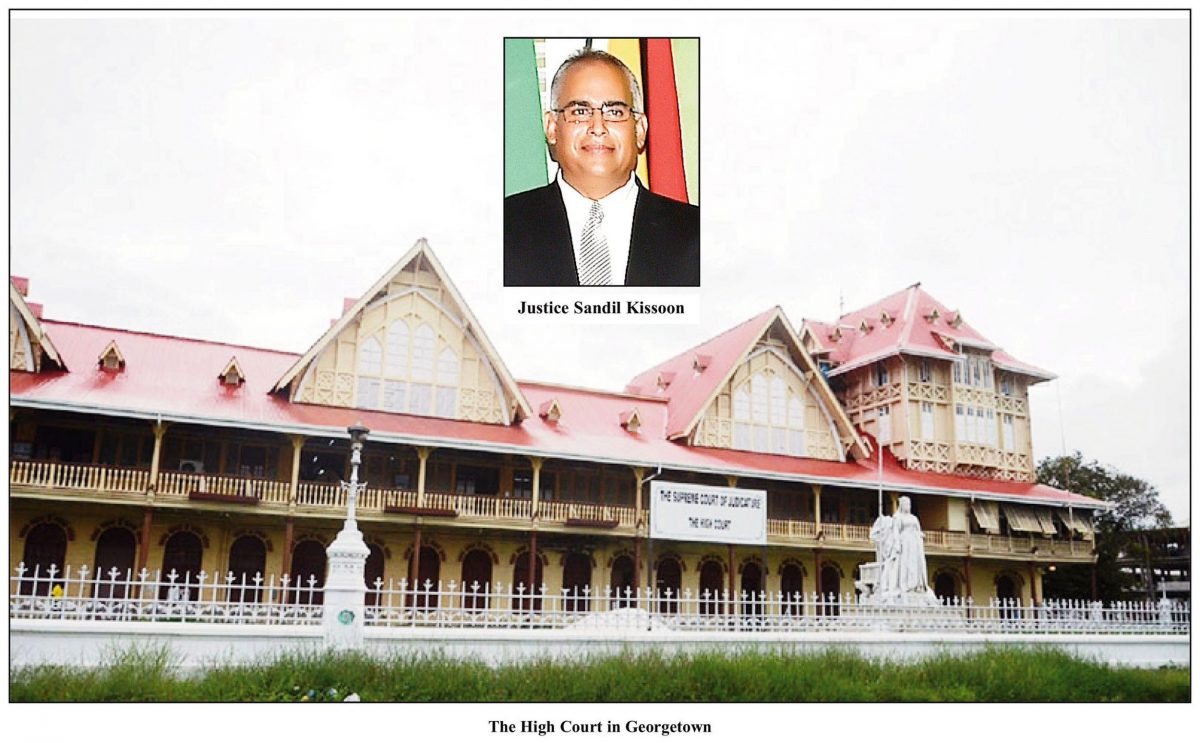In the action brought against the Environmental Protection Agency (EPA) to enforce the liability clause in the permits issued to ExxonMobil Guyana for its offshore oil operations, Justice Sandil Kissoon, in a ruling yesterday, said the EPA, which he described as “submissive,” had abdicated its responsibilities “…thereby putting this nation and its people in grave potential danger of calamitous disaster.”
The judge bluntly said that the circumstances giving rise to the action disclosed the existence of an “egregious state of affairs that has engulfed the Environmental Protection Agency in a quagmire of its own making.
“It has abdicated the exclusive statutory responsibilities entrusted to it by Parliament under the Environmental Protection Act 1996 and the Environmental Protection Regulations 2000 to ensure due compliance by Esso Exploration and Production Guyana Limited [EEPGL.”

 In response to the ruling, which he has signalled will be appealed, Attorney General Anil Nandlall said that both the government and EPA are of the considered view that the environmental permit “imposes no obligation” on the permit holder to provide an unlimited Parent Company Guarantee Agreement and/or Affiliate Company Guarantee Agreement.
In response to the ruling, which he has signalled will be appealed, Attorney General Anil Nandlall said that both the government and EPA are of the considered view that the environmental permit “imposes no obligation” on the permit holder to provide an unlimited Parent Company Guarantee Agreement and/or Affiliate Company Guarantee Agreement.
The AG’s position is that the ruling can have “profound ramifications and grave economic and other impacts on the public interest and national development.”
President of the Transparency Institute of Guyana Inc (TIGI) Fredericks Collins and another Guyanese citizen, Godfrey Whyte, had moved to the court last year to get the EPA to enforce the liability clause in the permits issued to ExxonMobil Guyana for its offshore oil operations.
The litigants had said that the resort to the court was to make sure that the company took full financial responsibility in case of harm, loss and damage to the environment. ExxonMobil’s local affiliate, EEPGL, has agreed in the permit to provide insurance and an unlimited parent company indemnity to cover all environmental loss and damage that might result from a well blowout, oil spill or other failures in the Liza 1 Development Project in Guyana’s Stabroek Block.
The duo, through their battery of attorneys led by Senior Counsel Seenath Jairam, had told the court that “…the agency, through its human minds, including its officers has failed or omitted to carry out or to show that it has carried out its legal duties and or obligations thereby amounting to misfeasance in public office by them and by failing or omitting to act, has acted unreasonably, irregularly or improperly and or has abused its power.”
Collins, in a statement, had said “I can’t even drive my car without insurance. So it is incomprehensible that the government would allow Esso to operate without any form of insurance. An oil spill would be devastating for our country and region as many Guyanese and Caribbean peoples depend on the ocean for their livelihoods. That is why we have decided that the time has come to take matters to the court for relief.”
“The EPA has relegated itself to a state of laxity of enforcement and condonation compounded by a lack of vigilance thereby putting this nation and its people in grave potential danger of calamitous disaster,” Justice Kissoon declared.
He said that in the course of the proceedings, the court found on the evidence that EEPGL was engaged in a “disingenuous attempt which was calculated to deceive when it sought to dilute its liabilities and settled obligations stipulated and expressed in clear unambiguous terms at Condition 14 of the Environmental Permit (Renewed) while simultaneously optimising production at the Liza Phase 1 Petroleum Production Project in the Stabroek Block Offshore Guyana.”
Directly calling out the EPA for its failings, the judge said that EEPGL “engaged in a course of action made permissible only by the omissions of a derelict, pliant and submissive Environmental Protection Agency.”
He said that the proceedings brought to the fore what is the adage, “but for the vigilance of citizens society shall perish.”
The court said it found that Esso was never in doubt as to what its liabilities were as captured under Condition 14 of the permit, as the stipulations were neither unusual, unique or unauthorised.
The judge said, “It was simply as a matter of law, fact, and consequence the norm that prevails which bound ESSO as singularly and exclusively responsible for all liabilities without restriction, implied or expressed, from its operations at the Liza Phase 1 Petroleum Production facilities, in the Stabroek Block.”
He further went on to highlight that it included all activities connected therewith as stipulated in condition 14 extending to and inclusive of the transition to petroleum production operations and all activities incidental thereto.
Equally, the judge said that the concomitant financial assurance obligations imposed on Esso by Condition 14:10 of the permit in the form of environmental liability insurance together with an unlimited parent company guarantee agreement “are but the legitimate corollary flowing from its uncapped and unlimited liabilities arising from an event and pollution as encapsulated in the permit, to provide such financial assurance, in the form of insurance and unlimited parent company guarantees to cover its liabilities.”
Justice Kissoon said these matters were not unknown to Esso or the EPA and consistent with the benefits of its petroleum production activities to which Esso was entitled, came the burden of fulfilling its obligations under the permit which were intended for the protection of the state, its citizens and the environment and for which the EPA was the sole authority mandated with oversight to ensure compliance.
Justice Kissoon was keen in pointing out that the EPA, before and subsequent to the filing of the matter, but for an order he had to make, refused to disclose any information as to the status of compliance by Esso with its financial assurance obligations for pollution damage set out at Condition 14 of the permit.
He said that the agency instead “sought refuge in silence, avoidance, concealment and secrecy notwithstanding the grave potential danger and consequences to the state and citizens if an event occurred at the Liza Phase 1…” in absence of such financial assurances mandated by the permit.
Justice Kissoon in all the circumstances went on to grant the applicants the orders they sought in the form of declarations. He also awarded them costs in the sum of $1,500,000.
The judge declared EPA to be in breach of its statutory duty by its failure and/or omissions to enforce compliance by EEPGL of its financial assurance obligations, and keep indemnified the agency and the Government of Guyana against all environmental obligations of the permit holder and co-venturers within the Stabroek Block.
He also specifically declared that EEPGL had failed to comply with its financial assurance obligation; and further that Con-dition 14 imposes on EEPGL, “unlimited and uncapped liability for all costs associated with clean up, restoration and compensation for all damages caused by any discharge of any contaminant arising from its exploration, development and petroleum production activities within the Stabroek Block.”
The judge ordered the EPA to issue an Enforcement Notice pursuant to Section 26 (1) and (2) of the Environmental Protection Act, no later than next Tuesday, directing EEPGL to perform its obligations under the permit and to provide, within 30 days thereafter, the unlimited liability Parent Company Guarantee Agreement and/or unlimited liability Affiliate Company Guarantee to indemnify and keep indemnified the Government of Guyana and the agency against all such environmental obligations of Esso and its co-venturers within the Stabroek block, together with environmental liability insurance as is customary in the international petroleum industry in accordance with the Conditions 14 from an insurance company standing and repute that equates to Grade A Plus as envisaged by Condition 14.
Failure to comply with the order, the judge said, will result in the permit being suspended.
Meanwhile, Nandlall said in a statement that the court fell into error in its findings. He said the EPA and EEPGL spent almost a year negotiating a Parent Guarantee and Indemnity Agreement to the tune of US$2 billion in liability coverage in compliance with EEPGL’s financial assurance obligations under the Environmental Permit and the Environmental Protection Act.
These negotiations only concluded last week, he said, and their material details were placed before the court for its consideration, “but unfortunately to no avail.”
In addition to Senior Counsel Jairam, the applicants were represented by attorneys Melinda Janki and Abiola Wong-Inniss.
The EPA was represented by attorneys Francis Carryl, Shareefah Parks and Naiomi Alsopp.
Meanwhile, EEPGL was represented by Senior Counsel Edward Luckhoo and Andrew Pollard along with Eleanor Luckhoo.





